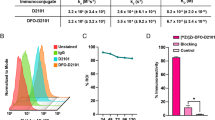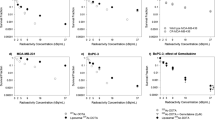Abstract
The pathogenesis of bone metastases may require the activation of osteoclasts by tumor-secreted factors, which promote important interactions with the bone microenvironment. We utilized an intratibial model of bone metastasis with bioluminescent imaging (BLI) to measure the effect of osteoclast inhibition on the interaction of human lung cancer cells with bone, and on tumor growth. Mice were injected with luciferase-transduced tumor cells (HARA, human pulmonary squamous carcinoma) and divided into three groups: (1) untreated, (2) twice weekly treatment with the bisphosphonate zoledronic acid (ZOL), or (3) osteoprotegerin (OPG). Histomorphometry and imaging were used to evaluate tumor burden, and parameters of osteoclast activity. Mice in the treated groups had increased bone density and decreased osteoclast numbers in nontumor-bearing tibiae. There was greater than 60% reduction in mean tumor volume in both treatment groups when evaluated by histomorphometry (P = 0.06 [OPG], P = 0.07 [ZOL]). However, bioluminescent imaging failed to show a reduction in tumor burden due to wide variability in the data. Osteoclast numbers along tumor-associated bone were significantly increased compared to tumor-free bone, and were not reduced by either treatment. Plasma calcium concentration was increased in all groups. Plasma tartrate-resistant acid phosphatase 5b was reduced in both treatment groups. Plasma PTHrP was significantly increased in the untreated tumor-bearing group, but was not significantly different in the two treatment groups compared to normal mice. OPG or ZOL did not change tumor cell proliferation, but ZOL increased HARA cell apoptosis. OPG and ZOL reduced tumor growth in the tibiae of treated mice, however, PTHrP production by HARA cells may have resulted in a high concentration in the bone microenvironment, partially overriding the antiosteoclast effects of both OPG and ZOL.
Similar content being viewed by others
Abbreviations
- BLI:
-
bioluminescent imaging
- IP:
-
intraperitoneal
- Luc:
-
luciferase
- OPG:
-
osteoprotegerin
- PTHrP:
-
parathyroid hormone-related protein
- SCC:
-
squamous cell carcinoma
- SQ:
-
subcutaneous
- TAB:
-
tumor-associated bone
- TRAcP:
-
tartrate-resistant acid phosphatase
- YFP:
-
yellow-fluorescent protein
- ZOL:
-
zoledronic acid
References
Jemal A, Thomas A, Murray T et al (2002) Cancer statistics, 2002. CA Cancer J Clin 52:23–47
Tu SM, Lin SH (2004) Clinical aspects of bone metastases in prostate cancer. In: Keller ET, Chung LWK (eds) The biology of skeletal metastases, 1st edn. Kluwer Academic Publishers, Boston, pp 23–46
Guise TA, Mundy GR (1998) Cancer and bone. Endocr Rev 19:18–54
Galasko CSB (1986) Incidence and distribution of skeletal metastases. In: Galasko CSB (ed) Skeletal metastases, 1st edn. Butterworths, London, pp 14–21
Paget S (1989) The distribution of secondary growths in cancer of the breast. 1889. Cancer Metastasis Rev 8:98–101
Stewart AF (2005) Hypercalcemia associated with cancer. N Engl J Med 352:373–379
Morton AR, Lipton A (1995) Hypercalcemia. In: Abeloff MD, Armitage JO, Lichter AS et al (eds) Clinical oncology, 1st edn. Churchill Livingstone, New York, pp 527–542
Weckmann MT, Grone A, Capen CC et al (1997) Regulation of parathyroid hormone-related protein secretion and mRNA expression in normal human keratinocytes and a squamous carcinoma cell line. Exp Cell Res 232:79–89
Wittrant Y, Theoleyre S, Chipoy C et al (2004) RANKL/RANK/OPG: new therapeutic targets in bone tumours and associated osteolysis. Biochim Biophys Acta 1704:49–57
Sellers RS, Capen CC, Rosol TJ (2002) Messenger RNA stability of parathyroid hormone-related protein regulated by transforming growth factor-beta1. Mol Cell Endocrinol 188:37–46
Guise TA, Yin JJ, Taylor SD et al (1996) Evidence for a causal role of parathyroid hormone-related protein in the pathogenesis of human breast cancer-mediated osteolysis. J Clin Invest 98:1544–1549
Rabbani SA, Gladu J, Harakidas P et al (1999) Over-production of parathyroid hormone-related peptide results in increased osteolytic skeletal metastasis by prostate cancer cells in vivo. Int J Cancer 80:257–264
Perry CM, Figgitt DP (2004) Zoledronic acid: a review of its use in patients with advanced cancer. Drugs 64:1197–1211
Rosen LS (2004) New generation of bisphosphonates: broad clinical utility in breast and prostate cancer. Oncology (Huntingt) 18:26–32
Ramaswamy B, Shapiro CL (2003) Bisphosphonates in the prevention and treatment of bone metastases. Oncology (Huntingt) 17:1261–1270
Boissier S, Ferreras M, Peyruchaud O et al (2000) Bisphosphonates inhibit breast and prostate carcinoma cell invasion, an early event in the formation of bone metastases. Cancer Res 60:2949–2954
Green JR (2003) Antitumor effects of bisphosphonates. Cancer 97:840–847
Cameron D (2003) Proven efficacy of zoledronic acid in the treatment of bone metastases in patients with breast cancer and other malignancies. Breast 12(Suppl 2):S22–S29
Rosen LS, Gordon D, Tchekmedyian NS et al (2004) Long-term efficacy and safety of zoledronic acid in the treatment of skeletal metastases in patients with nonsmall cell lung carcinoma and other solid tumors: a randomized, Phase III, double-blind, placebo-controlled trial. Cancer 100:2613–2621
Morony S, Capparelli C, Sarosi I et al (2001) Osteoprotegerin inhibits osteolysis and decreases skeletal tumor burden in syngeneic and nude mouse models of experimental bone metastasis. Cancer Res 61:4432–4436
Zhang J, Dai J, Qi Y et al (2001) Osteoprotegerin inhibits prostate cancer-induced osteoclastogenesis and prevents prostate tumor growth in the bone. J Clin Invest 107:1235–1244
Iguchi H, Tanaka S, Ozawa Y et al (1996) An experimental model of bone metastasis by human lung cancer cells: the role of parathyroid hormone-related protein in bone metastasis. Cancer Res 56:4040–4043
van der Pluijm G, Most W, van der Wee-Pals L et al (1991) Two distinct effects of recombinant human tumor necrosis factor-alpha on osteoclast development and subsequent resorption of mineralized matrix. Endocrinology 129:1596–1604
Halleen JM (2003) Tartrate-resistant acid phosphatase 5B is a specific and sensitive marker of bone resorption. Anticancer Res 23:1027–1029
Lipton A (2003) Bisphosphonates and metastatic breast carcinoma. Cancer 97:848–853
Eaton CL, Coleman RE (2003) Pathophysiology of bone metastases from prostate cancer and the role of bisphosphonates in treatment. Cancer Treat Rev 29:189–198
Yonou H, Kanomata N, Goya M et al (2003) Osteoprotegerin/osteoclastogenesis inhibitory factor decreases human prostate cancer burden in human adult bone implanted into nonobese diabetic/severe combined immunodeficient mice. Cancer Res 63:2096–2102
Body JJ, Greipp P, Coleman RE et al (2003) A phase I study of AMGN-0007, a recombinant osteoprotegerin construct, in patients with multiple myeloma or breast carcinoma related bone metastases. Cancer 97:887–892
Robinson VL, Kauffman EC, Sokoloff MH et al (2004) The basic biology of metastasis. Cancer Treat Res 118:1–21
Edinger M, Cao YA, Hornig YS et al (2002) Advancing animal models of neoplasia through in vivo bioluminescence imaging. Eur J Cancer 38:2128–2136
Kalikin LM, Schneider A, Thakur MA et al (2003) In vivo visualization of metastatic prostate cancer and quantitation of disease progression in immunocompromised mice. Cancer Biol Ther 2:656–660
Corey E, Brown LG, Quinn JE et al (2003) Zoledronic acid exhibits inhibitory effects on osteoblastic and osteolytic metastases of prostate cancer. Clin Cancer Res 9:295–306
Freireich EJ, Gehan EA, Rall DP et al (1966) Quantitative comparison of toxicity of anticancer agents in mouse, rat, hamster, dog, monkey, and man. Cancer Chemother Rep 50:219–244
Brown JE, Neville-Webbe H, Coleman RE (2004) The role of bisphosphonates in breast and prostate cancers. Endocr Relat Cancer 11:207–224
Saunders Y, Ross JR, Broadley KE et al (2004) Systematic review of bisphosphonates for hypercalcaemia of malignancy. Palliat Med 18:418–431
Akatsu T, Murakami T, Ono K et al (1998) Osteoclastogenesis inhibitory factor exhibits hypocalcemic effects in normal mice and in hypercalcemic nude mice carrying tumors associated with humoral hypercalcemia of malignancy. Bone 23:495–498
Capparelli C, Kostenuik PJ, Morony S et al (2000) Osteoprotegerin prevents and reverses hypercalcemia in a murine model of humoral hypercalcemia of malignancy. Cancer Res 60:783–787
Forsea AM, Muller C, Riebeling C et al (2004) Nitrogen-containing bisphosphonates inhibit cell cycle progression in human melanoma cells. Br J Cancer 91:803–810
Green JR, Clezardin P (2002) Mechanisms of bisphosphonate effects on osteoclasts, tumor cell growth, and metastasis. Am J Clin Oncol 25:S3–S9
Falzon M, Du P (2000) Enhanced growth of MCF-7 breast cancer cells overexpressing parathyroid hormone-related peptide. Endocrinology 141:1882–1892
Tovar SV, Shen X, Falzon M (2002) Intracrine PTHrP protects against serum starvation-induced apoptosis and regulates the cell cycle in MCF-7 breast cancer cells. Endocrinology 143:596–606
Holen I, Croucher PI, Hamdy FC et al (2002) Osteoprotegerin (OPG) is a survival factor for human prostate cancer cells. Cancer Res 62:1619–1623
Neville-Webbe HL, Cross NA, Eaton CL et al (2004) Osteoprotegerin (OPG) produced by bone marrow stromal cells protects breast cancer cells from TRAIL-induced apoptosis. Breast Cancer Res Treat 86:269–279
Yoneda T, Michigami T, Yi B et al (2000) Actions of bisphosphonate on bone metastasis in animal models of breast carcinoma. Cancer 88:2979–2988
Michigami T, Hiraga T, Williams PJ et al (2002) The effect of the bisphosphonate ibandronate on breast cancer metastasis to visceral organs. Breast Cancer Res Treat 75:249–258
Hiraga T, Williams PJ, Ueda A et al (2004) Zoledronic acid inhibits visceral metastases in the 4T1/luc mouse breast cancer model. Clin Cancer Res 10:4559–4567
Hillner BE, Ingle JN, Berenson JR et al (2000) American Society of Clinical Oncology guideline on the role of bisphosphonates in breast cancer. American Society of Clinical Oncology Bisphosphonates Expert Panel. J Clin Oncol 18:1378–1391
Acknowledgements
We would like to acknowledge Jeff Pan and Soledad Fernandez for statistical assistance, Tim Vojt for preparation of figures, Ann Saulsbery and Alan Flechtner for histotechnology support, University laboratory animal resources staff for animal care assistance, and Guangchun He and Drs. Gwendolyn Lorch, Ramiro Toribio, Alex Luchin, Nanda Thudi, Xiyun Deng, Jun Liu for laboratory support. Dr. Toribio also assisted with the statistical analysis. This work was supported by the National Institutes of Health, National Cancer Institute (K08 CA83766 for STG and R01 CA77911 for TJR) and the National Center for Research Resources (K26 RR00168 and S10 RR17841 for TJR).
Author information
Authors and Affiliations
Corresponding author
Rights and permissions
About this article
Cite this article
Tannehill-Gregg, S.H., Levine, A.L., Nadella, M.V.P. et al. The effect of zoledronic acid and osteoprotegerin on growth of human lung cancer in the tibias of nude mice. Clin Exp Metastasis 23, 19–31 (2006). https://doi.org/10.1007/s10585-006-9008-z
Received:
Accepted:
Published:
Issue Date:
DOI: https://doi.org/10.1007/s10585-006-9008-z




